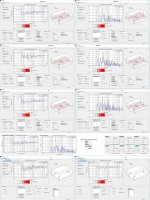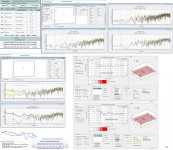Looking at options for 4 subs in room for a friend.
Been messing about with some designs and the Eminence Lab 12 seems to model best in near 100 litres tuned to around 20Hz or
Is there any real advantage of going for the Lab 15 in around 150 litres? again tuning to around 22Hz or a bit above, as the fs is surprisingly higher than the Lab 12
Thanks.
Been messing about with some designs and the Eminence Lab 12 seems to model best in near 100 litres tuned to around 20Hz or
Is there any real advantage of going for the Lab 15 in around 150 litres? again tuning to around 22Hz or a bit above, as the fs is surprisingly higher than the Lab 12
Thanks.
How big's the room, how loud/low do they want to go, and what amplification/processing do they have?
IME, 4x ported 12"s in a UK living room would have far more output than would ever be useful, unless they routinely throw loud parties.
Chris
IME, 4x ported 12"s in a UK living room would have far more output than would ever be useful, unless they routinely throw loud parties.
Chris
Chris,
18' x 25' x 9' ceiling
500w into 4 ohms each unit
20Hz preferably down to 16Hz in room
Sufficient for full orchestral full classical organ
Trying to decide if there is any performance advantage of going for the Lab 15" unit
18' x 25' x 9' ceiling
500w into 4 ohms each unit
20Hz preferably down to 16Hz in room
Sufficient for full orchestral full classical organ
Trying to decide if there is any performance advantage of going for the Lab 15" unit
"Demo" levels are usually around 105dB peaks at the listening position.
Without factoring in boundry/room gain, a set of four sealed 12"s will do 16Hz at 105dB @1m (ie, the only note playing is that bottom C, and it's at full power - not likely to happen, but headroom is good) with just over 13mm of excursion.
Factor in boundry gain, room gain, etc and four sealed 12"s will probably be more than adequate. No need to go ported.
Size the sealed box so that the desired power input allows it to reach Xmax, and EQ away.
Chris
Without factoring in boundry/room gain, a set of four sealed 12"s will do 16Hz at 105dB @1m (ie, the only note playing is that bottom C, and it's at full power - not likely to happen, but headroom is good) with just over 13mm of excursion.
Factor in boundry gain, room gain, etc and four sealed 12"s will probably be more than adequate. No need to go ported.
Size the sealed box so that the desired power input allows it to reach Xmax, and EQ away.
Chris
Room gain will kick in at 45hz. Ive seen some great lab 12 boxes built that extend below 30 in here... 45l sealed boxes would be flat to 10hz with room gain and xmax wouldnt exceed 19mm at 500w input. With 4 in a room you should get great sound and proper placement will reault in even bass at all listening positions.
I had a bk electronics monolith plus and to be honest there was a lot of port noise on the lower notes .it was distracting
"Demo" levels are usually around 105dB peaks at the listening position.
Without factoring in boundry/room gain, a set of four sealed 12"s will do 16Hz at 105dB @1m (ie, the only note playing is that bottom C, and it's at full power - not likely to happen, but headroom is good) with just over 13mm of excursion.
Factor in boundry gain, room gain, etc and four sealed 12"s will probably be more than adequate. No need to go ported.
Size the sealed box so that the desired power input allows it to reach Xmax, and EQ away.
Chris
Interesting thanks, Chris.
Room gain will kick in at 45hz. Ive seen some great lab 12 boxes built that extend below 30 in here... 45l sealed boxes would be flat to 10hz with room gain and xmax wouldnt exceed 19mm at 500w input. With 4 in a room you should get great sound and proper placement will reault in even bass at all listening positions.
Thanks Etocynned, A question.
How much EQ would be required to achieve this? I would rather use, if I needed, the EQ profiles built into this plate amp.
BSBPV500
Manual and details here, last two pages for details
http://www.bkelec.com/modules/BSBPV500%20Instructions.pdf
Last edited:
You're going to need a lot more EQ than that to get a multi-sub setup working properly. I'd budget for something like a MiniDSP 2x4 and go for rack mounted amplifiers.
Chris
Chris
You're going to need a lot more EQ than that to get a multi-sub setup working properly. I'd budget for something like a MiniDSP 2x4 and go for rack mounted amplifiers.
Chris
I will have to investigate further, not familiar with it, just searched it 2 i/p four o/p so it will handle four subs
miniDSP in a BOX : miniDSP 2x4
miniDSP in a BOX : miniDSP 2x4 HD
Last edited:
My only concern with this is that using it between pre/pow amps would compromise transparency of a high end system. Presumably it could be driven separately from a spare set of pre-amp outputs, separate from them main replay chain, so as to not compromise the main system?
Last edited:
My only concern with this is that using it between pre/por amps would compromise transparency of a high end system. Presumably it could be driven separately with a spare set of pre-amp outputs so as to not compromise the main system?
Depends on the main system.
You get the most benefit from subwoofers when the midrange speaker is no longer trying to produce bass, ie, with a highpass filter in there.
Next best is to have the midrange in a sealed enclosure, as the air spring stops the cone flapping around so much at very low frequencies. You'll get a 12dB/octave highpass slope to integrate the subs with.
Worst case is having the midrange in a ported enclosure, where it can flap around in response to low bass with no loading from the cabinet. It might be okay-ish, but all that flapping around is adding distortion.
I get that you want to keep things transparent, and to that end I'd just use the MiniDSP (or similar) to process the subwoofers. When you spread them around, they'll each have different frequency response curves that will need different EQ.
I'd probably put together a fixed analogue crossover for the main system, and aim to integrate the subs to that.
Chris
Depends on the main system.
You get the most benefit from subwoofers when the midrange speaker is no longer trying to produce bass, ie, with a highpass filter in there.
Next best is to have the midrange in a sealed enclosure, as the air spring stops the cone flapping around so much at very low frequencies. You'll get a 12dB/octave highpass slope to integrate the subs with.
Worst case is having the midrange in a ported enclosure, where it can flap around in response to low bass with no loading from the cabinet. It might be okay-ish, but all that flapping around is adding distortion.
I get that you want to keep things transparent, and to that end I'd just use the MiniDSP (or similar) to process the subwoofers. When you spread them around, they'll each have different frequency response curves that will need different EQ.
I'd probably put together a fixed analogue crossover for the main system, and aim to integrate the subs to that.
Chris
Yep
Your last para is my instinct, the mains he has are fairly full range devices with excellent power handling etc.
Just seen the BK Gemini subwoofer thread.
An interesting sub 4 of them could be an interesting proposition.
I had a bk electronics monolith plus and to be honest there was a lot of port noise on the lower notes .it was distracting
Yeah, a good rule is to tune a vent at, or slightly below, the lowest note needing box loading, so for pipe organ symphonies it's best overall to use either a well damped TL/MLTL or sealed alignment.
GM
As far as eq required ...none. The room gain is a 12db/octave boost below 45hz.
The eq you will most benefit from in a multisub setup, a la miniDSP, is cuts to resonant peaks excited by the subs in each location.
Search Geddes approach. You can get astoundingly flat reaponse from multiple small subs.
Taken far enough, investment of time in the tuning available via miniDSP, you can get astonishing output with a reliable driver like the Lab12.
The eq you will most benefit from in a multisub setup, a la miniDSP, is cuts to resonant peaks excited by the subs in each location.
Search Geddes approach. You can get astoundingly flat reaponse from multiple small subs.
Taken far enough, investment of time in the tuning available via miniDSP, you can get astonishing output with a reliable driver like the Lab12.
As far as eq required ...none. The room gain is a 12db/octave boost below 45hz.
Not reliably.
I measured one room that simply had a 10dB spike at 40Hz. Made small speakers sound big, and big speakers sound ugly.
The cabin gain model works well for sealed rooms - more like cars. Domestic spaces are usually anything but.
In my experience, relying on room gain to provide enough output will not work, unless you've done a lot of measurements and know the transfer function of the room really well.
Chris
Been doing a fair bit of modelling and will be going sealed box with the design, some EQ will be required and then with a mini DSP HD to balance the four subs, should be fun.
- Status
- Not open for further replies.
- Home
- Loudspeakers
- Subwoofers
- Two sub design options Eminence Lab 12 in 95 liters or Lab15 in 150 litres

